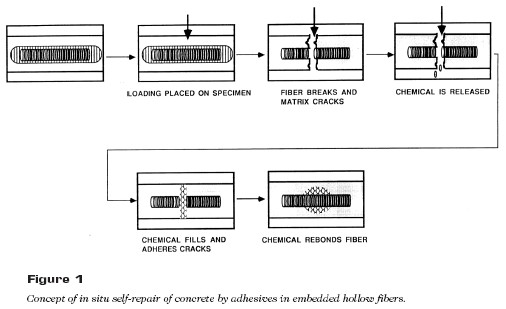This project evaluated the concept of self-repairing concrete containing fibers filled with adhesives (Figure 1) in large-scale laboratory and field tests. Four specific applications for this concept were explored in the laboratory and field experiments. In frames in the laboratory, it was shown that adhesive release from ruptured fibers helped distribute stress over the entire structure. In four full-scale bridge decks, the adhesive-filled tubes were put near the surface to function as creators of automatically fillable control joints. Surface shrinkage cracking acted to pull the brittle tubes apart and the sealant/adhesive flowed to fill the cracks. In another application, the adhesive-filled tubes were placed in the body of the deck to break due to shear cracking and repair these cracks. This type of release not only strengthened the decks but also distributed the stress to other locations. In the final application, large beams containing adhesive-filled tubes were tested to failure. The results showed added strength due to release of adhesives. The study also established the survival of adhesive-filled tubes during mixing in the concrete mixer, maintenance of the liquid phase of the adhesive, ease of finishing the concrete containing adhesive-filled fibers. Long-term field evaluation of bridge decks and pavements in a highway environment is needed to implement the rehabilitation technology. The final report is available from the National Technical Information Service (NTIS # PB2001-108551).

The final report for this IDEA project can be found at:
https://onlinepubs.trb.org/onlinepubs/archive/studies/idea/finalreports/highway/NCHRP037_Final_Report.pdf